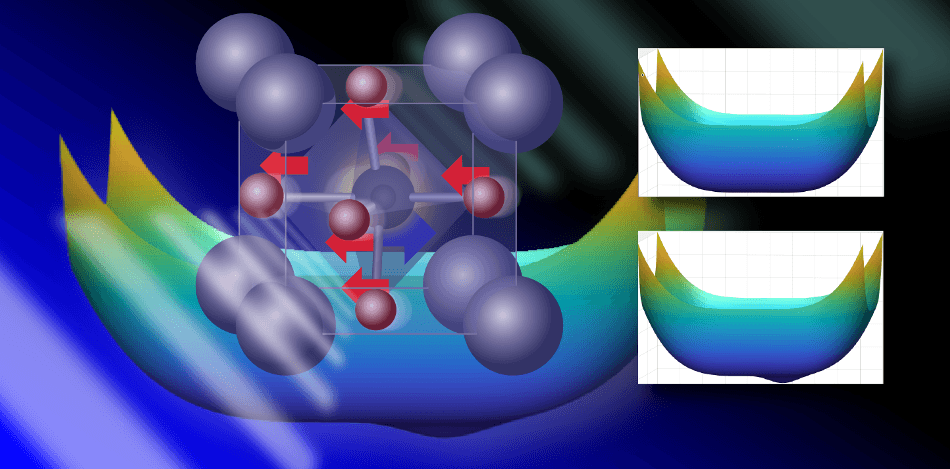Jun 14 2019
A majority of people believe that water exists in only one of three phases—gas vapor, liquid water, or solid ice. However, matter can exist in several different phases—for instance, ice has over 10 known phases, or ways through which its atoms can be spatially organized.
 A new study reveals a “hidden” phase of strontium titanate. On the left, extremely fast pulses of light excites atoms within the crystal structure (red arrows), which shifts the material into a new, ferroelectric phase. Vibrations of other atoms then work to stabilize the hidden phase (right panels). (Image credit: Felice Macera)
A new study reveals a “hidden” phase of strontium titanate. On the left, extremely fast pulses of light excites atoms within the crystal structure (red arrows), which shifts the material into a new, ferroelectric phase. Vibrations of other atoms then work to stabilize the hidden phase (right panels). (Image credit: Felice Macera)
The extensive use of piezoelectric materials, like ultrasound and microphones, is possible because of the basic understanding of the way an external force, like electricity, temperature, or pressure, can lead to phase transitions that permeate materials with novel characteristics.
Now, a recent study has revealed that there is a “hidden” phase in a metal oxide which imparts new, ferroelectric properties to the material; ferroelectric properties provide the potential to separate negative and positive charges, when the material is stimulated by very fast pulses of light.
MIT researchers Edoardo Baldini, Keith A. Nelson, and Xian Li, in association with Andrew M. Rappe and Penn graduate students Jiahao Zhang and Tian Qiu, headed the research. The results of the study have been reported in Science.
This latest research could lead to the development of new materials whose properties can be turned on and off in a trillionth of a second by simply flicking a switch and that too with relatively better control. Apart from changing the electric potential, this method can possibly be used for modifying other aspects of current materials—for instance, flipping the magnetic polarity of an insulator or converting it into a metal.
It’s opening a new horizon for rapid functional material reconfiguration.
Andrew M. Rappe, Blanchard Professor of Chemistry; Professor of Materials Science and Engineering, University of Pennsylvania
The team examined a paraelectric material—strontium titanate—that is used in resistors, resistors, and optical instruments. Featuring a symmetric and nonpolar crystal structure, strontium titanate can be “pushed” into a phase with a tetragonal, polar structure with two oppositely charged ions along its extended axis.
Previous collaboration of Rappe and Nelson offered the hypothetical basis for this latest work, which depended considerably on Nelson’s know-how using light to promote phase transitions in solid materials, together with Rappe’s expertise in creating atomic-level computer models.
[Nelson is] the experimentalist, and we’re the theorists. He can report what he thinks is happening based on spectra, but the interpretation is speculative until we provide a strong physical understanding of what happened.
Andrew M. Rappe, Blanchard Professor of Chemistry; Department of Chemistry, School of Arts and Sciences University of Pennsylvania
Rappe is also a Professor in the Department of Materials Science and Engineering in the School of Engineering and Applied Science at the University of Pennsylvania.
With the latest advancements in technology, along with additional know-how obtained from working with terahertz frequencies, both the chemists set out to see whether their hypothesis, currently more than 10 years old, held true.
For Rappe, a major difficulty was to complement Nelson’s experiments with a precise computer-created version of strontium titanate—with each single atom monitored and represented—that reacts to light in the same way as the material being reexamined in the laboratory.
The team discovered that when light is used to excite strontium titanate, the ions are pulled in various directions, with negatively charged ions moving in one direction and positively charged ions moving in the other. Afterward, the ions do not fall immediately back into place, the way a pendulum would normally do after it has been pushed, but rather, the ions are prevented from swinging back instantly by the vibrational movements promoted in the other atoms. It is as if the pendulum is slightly diverted off course the moment it reaches the highest height of its oscillation, and is held in place away from its starting position by a tiny notch.
Due to their powerful history of collaboration, both Rappe and Nelson were able to go back and forth from the hypothetical simulations to the experiments, and vice versa, until they came across experimental proof that revealed that their hypothesis indeed held true.
It’s been a really awesome collaboration. And it illustrates how ideas can simmer and then return in full force after more than 10 years.
Keith A. Nelson, Haslam and Dewey Professor, Department of Chemistry, MIT
Both chemists will team up with engineers on upcoming applications-driven studies, like producing innovative materials that have concealed phases, varying light-pulse protocols to produce phases that last for a longer time, and observing how this method works for nanomaterials. For now, the two investigators are happy about their results and where this important innovation would lead to in the coming days.
It’s the dream of every scientist—to hatch an idea together with a friend, to map out the consequence of that idea, then to have a chance to translate it into something in the lab, it’s extremely gratifying. It makes us think we’re on the right track towards the future.
Andrew M. Rappe, Blanchard Professor of Chemistry; Department of Chemistry, School of Arts and Sciences University of Pennsylvania
The study was supported by the Department of Energy Office of Basic Energy Sciences grants DE-SC0019126 and DE-FG02-07ER46431 and Swiss National Science Foundation fellowship P2ELP2-172290. The National Energy Research Scientific Computing Center of the Department of Energy provided computational support.